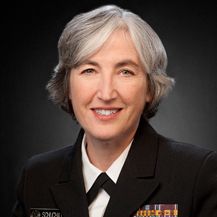Heart Break: Preventive Aspirin Use, Physical Activity on the Decline
The CDC reports that, while tobacco use has decreased, cardiovascular disease risk factors and rates of cardiovascular management are still in need of improvement.

Anne Schuchat, MD
The US Centers for Disease Control and Prevention (CDC) is looking to make good on its five-year goal to prevent 1 million acute cardiovascular events in that span of time, dubbed the Million Hearts 2022. But according to their new analysis, they have their work cut out for them.
According to data assessed from 3 separate national health surveys, cardiovascular event risk factors such as sodium intake and limited blood pressure control were highly prevalent in the US as of 2015-16. While other rates of other factors such as combustible tobacco use improved since 2011-12, physical activity and use of preventive therapies such as aspirin worsened.
In a new study presented in the CDC’s Morbidity and Mortality Weekly Report this week, investigators reported that the rate of aspirin use for primary or secondary cardiovascular disease prevention significantly decreased from 69.2% to 60.8% patients in the 2 compared time periods. In patient totals that could equate to about 9 million people in the US no longer taking a recommended preventive therapy.
Led by Hilary K. Wall, MPH, of the Division for Heart Disease and Stroke Prevention at the CDC, investigators analyzed comparative six-year data from the National Health and Nutrition Examination Survey, the National Survey on Drug Use and Health, and the National Health Interview Survey. They conducted multivariate assessments to spots key differences among all patient subgroups at risk of cardiovascular disease versus the rates reported in 2011-12.
Though cardiovascular disease mortality rates have steadily dropped in the past 4 decades, heart disease and stroke remain the first and fifth leading causes of death in the US, respectively—highlighting the need to address patient characteristics. What’s more, heart disease has become an outstanding burden of costs on the average US patient, investigators noted.
“CVD annually accounts for approximately $330 billion in direct and indirect costs in the United States: approximately one in seven health care dollars is spent on CVD,” they wrote.
In response, the US Department of Health and Human Services launched Million Hearts 2022 in 2012, to be co-led by the CDC and Centers for Medicare & Medicaid Services. Having completed foundational work to the project in its first 5 years, the agencies are now looking to accelerate its practices and strategies through 2022.
“During 2017—2021, Million Hearts 2022 priorities are keeping adults healthy through community-based strategies that reduce combustible tobacco use, sodium intake, and physical inactivity as well as optimizing health care for those with and at risk for CVD through clinical strategies that improve appropriate aspirin use, blood pressure control, cholesterol management, tobacco cessation, and participation in cardiac rehabilitation,” investigators wrote.
With that in mind, the decrease in aspirin intake rates is a noted concern for the investigators—as is the rate of blood pressure (BP) control. The assessment reported that just 48.5% of surveyed people have BP control, equating to an estimated 40.2 million persons with uncontrolled hypertension. The patient populations with notably lower rates of BP control included those aged 18-44 years (40.0%) and non-Hispanic black people (44.3%).
Investigators noted no significant change in BP control from compared time periods, as well as for the rates of cholesterol management through statin use among eligible adults. In 2013-14, statin-use management was 54.5%, and again lower in middle-aged adults (45-64 years = 50.3%) and minorities (Hispanics = 33.7%).
However, combustible tobacco product use significantly declined in adults in recent years, from 25.1% in 2011-12 to 22.3% in 2015-16. Tobacco use was notably more prevalent in men (26.7%) than women (18.1%), and in white people (24.0%) than minorities (non-Hispanic Asians = 10.3%; Hispanics = 16.0%).
Mean daily sodium intake among adults was 3535 mg/day in 2015-16—insignificantly different from rates reported in 2011-12. Again, men were more likely to report grater consumption (4095 mg/day) than women (3013 mg/day). Among age groups, persons 18-44 years old reported the greatest men daily sodium intake (3809 mg/day).
Physical inactivity slight—yet statistically significantly—decreased from 30.9% in 2011-12 to 29.1% in 2015-16. Investigators estimated this represents a population of 70.7 million adults who currently do not partake in any leisure time physical activity. Prevalence of inactivity was greatest among women (30.7%), black people (36.9%) and Hispanics (36.1%).
In their attempt to significantly reduce nationwide rates of cardiovascular disease, Million Hearts 2022 is focused on improving the rates of combustible tobacco use, physical activity, and daily sodium intake each by 20%. Not only does this baseline data suggest initiatives for certain risk factors, but it also gives investigators indication of which patient populations are at greatest need.
“Evidence-based strategies for preventing acute cardiovascular events exist, with 213 million opportunities for better risk factor prevention and management,” investigators concluded. “It will require a concerted national implementation effort to prevent one million acute cardiovascular events by 2022.”
Anne Schuchat, MD, principal deputy director of the CDC, added that adults are granted daily opportunities to improve on the various factors of cardiovascular disease—and inherently, reduce their risk of heart attack or stroke significantly.
“Many of these cardiovascular events are happening to middle-aged adults— who we wouldn’t normally consider to be at risk,” Schuchat said. “Most of these events can be prevented through daily actions to help lower risk and better manage medical conditions.